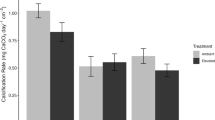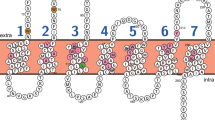Abstract
Acclimation to high light conditions on the top of coral reefs was examined in the coenocytic, filamentous green macroalga Chlorodesmis fastigiata (C. Ag.) Ducker. Despite having a pool of violaxanthin, high light does not induce formation of zeaxanthin in this macroalga. Exposure to 11 and 33% of surface irradiance resulted in parallel, reversible declines in Fv/Fmand in the number of functional PSII centers. The quantum requirement for PSII inactivation was calculated to be approx. 2×107photons. Recovery of PSII activity after low photon exposures did not depend on protein synthesis, unlike at higher photon exposures, where recovery was inhibited by 50% in the presence of lincomycin. Accumulation of inactive, quenching PSII centers is proposed as a mechanism of energy dissipation; only some of these centers require protein synthesis for reactivation. In natural-sized populations, midday photoinhibition was greater in filament tips than in bases, but the number of inactive PSII centers within entire filaments did not significantly change over the course of the day. It is proposed that the higher chlorophyll concentration in the tips provides protective shading to chloroplasts in lower regions, and that cytoplasmic streaming of chloroplasts within this siphonous alga limits the cumulative exposure to high light, thereby providing another level of protection from high light stress.
Similar content being viewed by others
References
Anderson J (1983) Chlorophyll-protein complexes of a Codium species, including a light-harvesting siphonaxanthin-chlorophyll a/b-protein complex, an evolutionary relic of some Chlorophyta. Biochim Biophys Acta 724: 370-380
Arsalane W, Rousseau B and Duval JC (1994) Influence of the pool size of the xanthophyll cycle on the effects of light stress in a diatom: Competition between photoprotection and photoinhibition. Photochem Photobiol 60: 237-243
Chow WS (1994) Photoprotection and photoinhibitory damage. In: Barber J (ed) Advances in Molecular and Cell Biology. Molecular Process of Photosynthesis, Vol 9, pp 151-196. JAI Press, Greenwich, CT
Chow WS, Hope AB and Anderson JM (1991) Further studies on quantifying Photosystem II in vivo by flash-induced oxygen yield from leaf discs. Aust J Plant Physiol 18: 397-410
Chow WS, Osmond CB and Huang L-K (1989) Photosystem II function and herbicide binding sites during photoinhibition of spinach chloroplasts in-vivoand in-vitro. Photosynth Res 21: 17-26
Critchley C and Russell AW (1992) Maximizing light interception: The role of photoplast disposition in cells and thylakoid membrane architecture. In: Abrol YP, Mohanty P and Govindjee (eds) Photosynthesis. Photoreaction to Plant Productivity, pp 257-276. Oxford and IBH Publishing, New Delhi
Demmig-Adams B and Adams WW III (1992) Photoprotection and other responses of plants to high light stress. Ann Rev Plant Physiol Plant Mol Biol 43: 599-626
Dring MJ (1981) Chromatic adaptation in benthic marine algae: An examination of its ecological significance, using a theoretical model. Limnol Ocean 26: 271-284
Duval J-C, Harker M, Rousseau B, Young AJ, Britton G and Lemoine Y (1992) Photoinhibition and zeaxanthin formation in the brown algae Laminaria saccharinaand Pelvetia canaliculata. In: Murata N (ed) Research in Photosynthesis, Vol 14, pp 581-584. Kluwer Academic Publishers, Dordrecht, the Netherlands
Franklin LA (1994) The effects of temperature acclimation on the photoinhibitory responses of Ulva rotundataBlid. Planta 192: 324-331
Franklin LA, Levavasseur G, Osmond CB, Henley WJ and Ramus J (1992) Two components of onset and recovery during photoinhibition of Ulva rotundata. Planta 186: 399-408
Franklin LA, Seaton GGR, Lovelock C and Larkum AWD (1996) Photoinhibition on a coral reef. Plant Cell Environ 19: 825-836
Genty B, Briantais, JM and Baker NR (1989) The relationship between the quantum yield of photosynthetic electron transport and quenching of chlorophyll fluorescence. Biochim Biophys Acta 990: 87-92
Gilmore AM and Yamamoto HY (1991) Resolution of lutein and zeaxanthin using a nonendcapped, lightly carbon loaded C-18 high-performance liquid chromatographic column. J Chromatogr 543: 137-145
Greer DH, Berry JA, Björkman O (1986) Photoinhibition of photosynthesis in intact bean leaves: Role of temperature, and requirement for chloroplast-protein synthesis during recovery. Planta 168: 253-260
Guenther, JE and Melis A (1990) The physiological significance of Photosystem II heterogeneity in chloroplasts. Photosynth Res 23: 105-109
Hanelt D and Nultsch W (1991) The role of chromatophore arrangement in protecting the chromatophores of the brown alga Dictyota dichotomaagainst photodamage. J Plant Physiol 138: 470-475
Hanelt D, Huppertz K and Nultsch W (1993) Daily course of photosynthesis and photoinhibition in marine macroalgae investigated in the laboratory and in the field. Mar Ecol Prog Ser 97: 31-71
Henley WJ, Lindley ST, Levavasseur G, Osmond CB and Ramus J (1992) Photosynthetic responses of Ulva rotundatato light and temperature during emersion on an intertidal sand flat. Oecologia 89: 516-523
Horton P, Ruban A and Walters RG (1996) Regulation of light harvesting in green plants. Ann Rev Plant Physiol Plant Mol Biol 47: 655-684
Hurry VM and Huner NPA (1992) Effect of cold hardening on sensitivity of winter and spring wheat leaves to short-term photoinhibition and recovery of photosynthesis. Plant Physiol 100: 1283-1290
Kirilovsky D, Vernotte C and Etienne A-L (1990) Protection from photoinhibition by low temperature in Synechocystis6714 and in Chlamydomonas reinhardtii: Detection of an intermediary state. Biochem 29: 8100-8106
Kleinig, H (1969) Carotenoids of siphonous green algae: A chemotaxonomical study. J Phycol 5: 281-284
Krause GH and Weis E (1991) Chlorophyll fluorescence and photosynthesis: The basics. Ann Rev Plant Physiol Plant Mol Biol 42: 312-349
Kübler JE and Raven J (1996a) Inorganic carbon acquisition by red seaweeds grown under dynamic light regimes. Hydrobiol 326/327: 401-406
Kübler JE and Raven J (1996b) Nonequilibrium rates of photosynthesis and respiration under dynamic light supply. J Phycol 32: 963-969
Larkum AWD and Barrett J (1983) Light-harvesting processes in algae. In: Woolhouse HJ (ed) Advances in Botanical Research, Vol 10, pp 3-219. Academic Press, London
Leitsch J, Schnettger B, Critchley C and Krause GH (1994) Two mechanisms of recovery from photoinhibition in vivo: Reactivation of Photosystem II related and unrelated to D1-protein turnover. Planta 194: 15-21
Long SP, Humphries S and Falkowski PG (1994) Photoinhibition of photosynthesis in nature. Ann Rev Plant Physiol Plant Mol Biol 45: 633-662
Menzel D (1985) Fine structure study on the association of the cauler-palean plastid with microtubule bundles in the siphonalean green alga Chlorodesmis fastigiata(Ducker, Udoteaceae). Protoplasma 125: 103-110
Mishkind M and Mauzerall D (1980) Kinetic evidence for a common photosynthetic step in diverse seaweeds. Mar Biol 56: 261-265
Ohad I, Keren N, Zer H, Gong H, Mor TS, Gal A, Tal S and Domovich Y (1994) Light-induced degradation of the Photosystem II reaction centre D1 protein in vivo: An integrative approach. In: Baker NR and Bowyer JR (eds) Photoinhibition of photosynthesis, From the Molecular Mechanism to the Field, pp 161-177. BIOS Scientific Publ., Oxford
Öquist G, Chow WS and Anderson JM (1992) Photoinhibition of photosynthesis represents a mechanism for the long-term regulation of Photosystem II. Planta 187: 450-460
Öquist G, Campbell D, Clarke AK and Gustafsson P (1995) The cyanobacterium Synechococcusmodulates Photosystem II function in response to excitation stress through D1 exchange. Photosynth Res 46: 151-158
Osmond CB (1994) What is photoinhibition? Some insights from comparisons of shade and sun plants. In: Baker NR and Bowyer JR (eds) Photoinhibition of Photosynthesis, From the Molecular Mechanism to the Field, pp 1-24. BIOS Scientific Publ., Oxford
Park Y-I, Anderson JM and Chow WS (1996) Photoinactivation of functional Photosystem II and D1-protein synthesis in vivoare independent of the modulation of the photosynthetic apparatus by growth irradiance. Planta 198: 300-309
Park Y-I, Chow WS and Anderson JM (1995) Light inactivation of functional Photosystem II in leaves of peas grown in moderate light depends on photon exposure. Planta 196: 401-411
Porra RJ, Thompson WA and Kriedemann PE (1989) Determination of accurate extinction coefficients and simultaneous equations for assaying chlorophylls aand bextracted with four different solvents: Verification of the concentration of chlorophyll standards by atomic absorption spectroscopy. Biochim Biophys Acta 975: 384-394
Prášil O, Adir N and Ohad I (1992) Dynamics of Photosystem II: Mechanism of photoinhibition and recovery processes. In: Barber J (ed) Topics in Photosynthesis. The Photosystems: Structure, Function and Molecular Biology, Vol 11, pp 295-348. Elsevier, Amsterdam
Rabinowitch EI (1951) Photosynthesis and Related Processes, Vol II, Pt 2. Interscience, New York
Ramus J (1978) Seaweed anatomy and photosynthetic performance: The ecological significance of light guides, heterogeneous absorption and multiple scatter. J Phycol 14: 352-362
Ramus J and van der Meer JP (1983) A physiological test of the theory of complementary chromatic adaptation. I. Color mutants of a red seaweed. J Phycol 19: 86-91
Russell AW, Critchley C, Robinson SA, Franklin LA, Seaton GGR, Chow WS, Anderson JM and Osmond CB (1994) Photosystem II regulation and dynamics of the chloroplast D1 protein in Arabidopsisleaves during photosynthesis and photoinhibition. Plant Physiol 107: 943-952
Schnettger B, Critchley C, Santore UJ, Graf M and Krause GH (1994) Relationship between photoinhibition of photosynthesis, D1 protein turnover and chloroplast structure: Effects of protein synthesis inhibitors. Plant Cell Environ 17: 55-64
Schreiber U, Bilger W and Neubauer C (1994) Chlorophyll fluorescence as a nonintrusive indicator for rapid assessment of in vivophotosynthesis. In: Schulze E-D and Caldwell MM (eds) Ecophysiology of Photosynthesis, pp 49-70. Springer-Verlag, Berlin
Somersalo S and Krause GH (1990) Reversible photoinhibition of unhardened and cold-acclimated spinach leaves at chilling temperatures. Planta 180: 181-187
Urmacher S, Hanelt D and Nultsch W (1995) Zeaxanthin content and the degree of photoinhibition are linearly correlated in the brown alga Dictyota dichotoma. Mar Biol 123: 159-165
Vershinin AO and Kamnev AN (1996) Xanthophyll cycle in marine macroalgae. Bot Mar 39: 421-425
Weis E and Berry J (1987) Quantum efficiency of Photosystem II in relation to energy-dependent quenching of chlorophyll fluorescence. Biochim Biophys Acta 894: 198-208
Author information
Authors and Affiliations
Rights and permissions
About this article
Cite this article
Franklin, L.A., Larkum, A.W. Multiple strategies for a high light existence in a tropical marine macroalga. Photosynthesis Research 53, 149–159 (1997). https://doi.org/10.1023/A:1005820203585
Issue Date:
DOI: https://doi.org/10.1023/A:1005820203585




